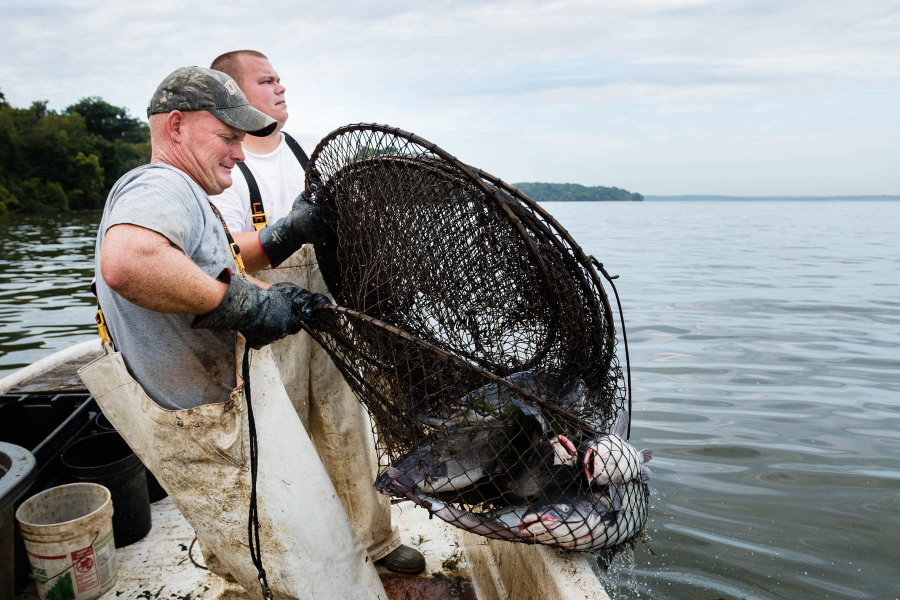Understanding the threat of invasive catfish
Two new reports look into the biology and management of blue and flathead catfish

Whether it’s browsing the seafood counter at your local grocery store or enjoying a boat ride down the James River, you may have encountered one of the Bay’s most notorious invasive species: the blue catfish. Originally native to the Mississippi, Missouri and Ohio River basins, the blue catfish and its cousin, the flathead catfish, were introduced into Virginia waters by the state several decades ago to establish a recreational fishery. Since that time, these large, long-lived fish have expanded throughout much of the Chesapeake Bay region.
To help understand what is currently known about these fish and how to manage their spread, the Chesapeake Bay Program convened an Invasive Catfish Task Force of state and federal agencies, academic institutions and other stakeholders to discuss the best coordinated management options for controlling the spread and population growth of these species. The task force recently released two reports synthesizing what is known about invasive catfish and offering recommendations for managing their spread.
The threat of invasive catfish
Blue catfish can tolerate higher salinity and eat a wide variety of prey, including blue crabs, Asian clams, insects, other fish and even vegetation. Flathead catfish are more prevalent in less salty waters, like the Susquehanna River, and feed mostly on other fish.
Their growing numbers and rapid expansion throughout the region have raised concern about their potential impact on shad, menhaden, blue crabs and other native species that play an important role in our ecosystem and economy.

Managing the spread of blue and flathead catfish
Preventing the spread of invasive catfish is the most effective way to avoid harmful impacts on invasive native species. Once a species is established, controlling it requires significant and sustained resources. The Invasive Catfish Task Force offers seven recommendations to help prevent the spread of invasive catfish.
- Remove invasive catfish from priority areas.
- Develop a commercial fishery.
- Evaluate removal methods.
- Develop monitoring and response plans.
- Evaluate habitat connectivity.
- Review fishing policies and regulations.
- Increase public awareness.
Coordination is key
One important element to making these actions as useful as possible is coordination. If actions are applied unevenly across the watershed, the catfish can move from one place to the other. Catfish can travel long distances and blue catfish in particular can tolerate saltier waters. In years like 2018, when the Bay received record-breaking rainfall, they can take advantage of the lower salinity and move into the Bay to spread into new rivers.
Not all states have a dedicated monitoring program and those that do are not coordinated together. There needs to be more consistent monitoring across the jurisdictions—Delaware, the District of Columbia, Maryland, New York, Pennsylvania, Virginia and West Virginia—so if invasive catfish move to a new area, managers can respond to it before they establish themselves.
That’s why the Bay Program’s Invasive Catfish Task Force has been working since its establishment in 2012 to bring together scientists and managers from across the watershed to learn from each other and work toward a coordinated response to blue and flathead catfish. While a coordinated, Bay-wide management plan has not yet been developed for invasive catfish, the task force will continue to serve an information exchange role and foster collaboration among management jurisdictions.
Learn more about the impact of invasive species in the region.

Comments
Just spent a weekend on the Rappahannock River south of the 360 bridge. The only species of fish my son and I caught were Blue Catfish. Upwards of 70-80 over a 2 day period.
Hi Trace, unfortunately, we do not have a presentation on invasive blue catfish to share. But you are welcome to use all the information and media on our website.
Can you make a presentation about blue catfish in the bay for 6th graders? I need it for a really important school project. Thank you
Has anyone ever thought about shocking the blues putting them in a truck and driving them to San Diego lakes. I'm sure the lakes here would take as many as you could put on a truck. I would drive them here and drop off in our lakes. You have so many ways to solve the problem. Just ask someone who fishes relocating I am more than willing to drive a truck full of blues and drop in our lakes thank you Eric Murry
What methods?
it didn't tell me anything about how they were succsesful.
I am doing an invasive species project and I need something that shows how the flathead catfish disrupts its native environment.
Greg, blue catfish were introduced into the Rappahannock and James rivers by the state of Va. in the 1970s to support sport fishing. The Chesapeake Bay Program is actively working with entities across the watershed to manage the population. This blog has more information you might find interesting! https://www.chesapeakebay.net/news/blog/understanding_the_threat_of_invasive_catfish.
I was out fishing this past weekend near the Bay Bridge for Rock Fish. We did not catch any Rock but did catch 19 Blue Catfish. Most in the 24 to 30 inch verity. I am reading these articles to find out what is going on. Yes, they were fun to catch but a little creepy as well. First of all, it should be a red flag when any state or jurisdictional regulator decides to introduce anything that isn't native to the area and I would have hoped that regulators would have passed laws against this nonsense. We as a species do not have the intelligence to know when not to interfere with the natural course of life. We think we are clever to introduce something into the environment that will take care of another nuisance only to realize we have created a bigger problem. With that said, if these fish were introduced from the Mississippi River, why would we not know how they interact with other species found in that tributary and be able to determine what impact we can expect on the Chesapeake?
The Chesapeake Bay Program (www.chesapeakebay.net) convened an Invasive Catfish Task Force to look at blue catfish in the Chesapeake Bay. The task force is a subset of our Sustainable Fisheries Goal Implementation Team and information on their work can be found at - https://www.chesapeakebay.net/who/group/invasive_catfish_task_force.
I am researching for a project and would find it very helpful if there was a link to this organization that is taking action.
Blue and Flathead Catfish are the best thing to happen to our region and here we are decades later and the food chain hasn't collapsed, take your scare tactics to an uninformed populace.
Can you provide a source link to the research papers that show that the Blue Catfish is an invasive species to any waterway in Virginia? It's my understanding during a public meeting that no one has any research that showed that they were(2014). Would like to see any new studies that have been submitted for peer-review that shows clearly that Blue Catfish are invasive.
Thank you,
Thank you!
Your comment has been received. Before it can be published, the comment will be reviewed by our team to ensure it adheres with our rules of engagement.
Back to recent stories